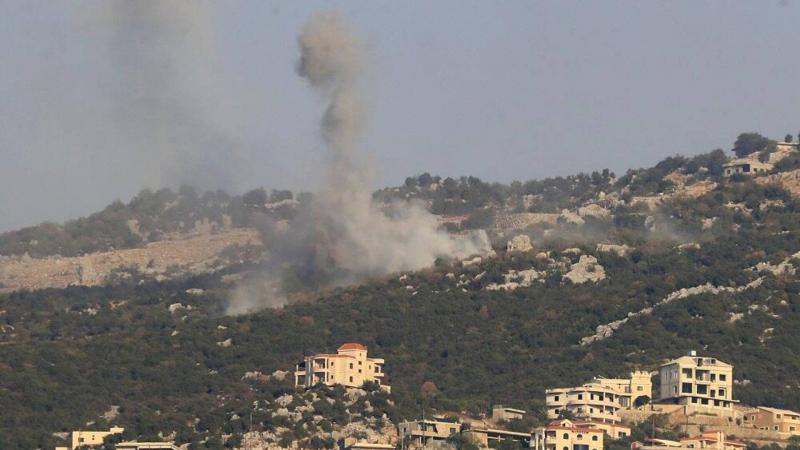The field indicators in southern Lebanon reflect at least four military and political goals that shape Hezbollah's strategy, beginning with sending messages of readiness to engage in the Gaza war, affirming commitment to the provisions of Resolution 1701, establishing a buffer zone of about 5 kilometers on the Israeli side, and paving the way for border breaches by Palestinian organizations.
Hezbollah began its military operations 24 hours after the Gaza battle commenced, targeting military sites in the Shebaa Farms and Kfarshouba hills, which Lebanon considers occupied. This was seen as a strike "within the rules of engagement," according to Hicham Jaber, head of the Middle East Studies Center. The targeting expanded into exchanges of fire after two members of Islamic Jihad crossed the border along with another group and clashed with the Israeli army. Israel responded by bombing a site belonging to Hezbollah, resulting in the deaths of three of its members on Monday, October 9, which led to mutual retaliations and civilian displacements from border villages. Concurrently, Israeli settlements were evacuated up to 7 kilometers into the northern border colonies with Lebanon.
Jaber, a retired Lebanese army general, states that Hezbollah, in its bombardment, wishes to avoid expanding the conflict as long as it achieves its desired goals and keeps it limited. The goal is to divert three military divisions, exceeding 30,000 Israeli soldiers, to be on alert along the Lebanese border without engaging in the Gaza battle. Additionally, he notes that "Hezbollah will not initiate a battle, due to internal front concerns and to prevent igniting a regional war."
Jaber highlights that, in this sense, Hezbollah is trying to convey a political message, demonstrating commitment to Resolution 1701, as evidenced by not firing medium or short-range missiles and only using bullets and anti-tank rockets that focused on Israeli positions without reaching civilian towns and settlements. Furthermore, it is targeting Israeli objectives within an area that is supposed to be militarily unoccupied, as it is disputed between the international border and the Blue Line, even though Israel militarily occupies it. However, this does not negate the political message announced and reiterated by its officials since last week, which is solidarity with Gaza and support for Hamas in the confrontations, creating an atmosphere of confusion for Israeli forces on the northern border and continuous mobilization while sending messages of readiness to engage in the war.
Hezbollah has been targeting electronic devices, early warning systems, and surveillance cameras, with media estimates close to the party claiming that 40 percent of the electronic equipment facing Lebanon has been struck. Jaber, a military expert, asserts that the party is therefore "trying to prove that the wall built by Israel along the border is ineffective and is preparing for war after reducing intelligence capabilities and decreasing the ability to know what is beyond the wall from the Lebanese side, as it has disabled highly sensitive devices that detect infiltrators."
So far, the bombardments have not exceeded three kilometers into Lebanese territory, indicating that clashes remain near the border, but developments have prompted Israel to evacuate settlements to as far as about 7 kilometers inward to keep civilians away from the range of missiles intermittently launched by Palestinian organizations, some of which reached the Kiryat Shmona settlement.
Simultaneously, field indicators suggest that the party, which has widely used "Kornet" missiles (with a range of 5 kilometers) to target Israeli armored vehicles and soldiers, has managed to establish a buffer zone of about 5 kilometers on the Israeli side of the Lebanese border. Jaber states that Hezbollah has not yet used the Kornet at ranges exceeding two kilometers in striking armored vehicles and personnel, while it has used it over longer distances to hit equipment and radars at elevated sites in Shebaa Farms. However, "it has enforced a fire zone within the Kornet range, targeting any vehicle or individuals visible along the border in that area."
This fire-imposed buffer zone, along with the destruction of cameras and disabling of surveillance and warning devices, paves the way for military operations inside the border. Indicators of such operations appeared following the infiltration of a Palestinian group in the first week and two groups in the second week, one of which was claimed by the Al-Qassam Brigades. Jaber acknowledges that "this indeed paves the way for infiltration and launching operations inside if Hezbollah decides so, but this does not resemble the Cairo Agreement of 1969, which allowed the Palestinian resistance to launch operations from Lebanese territory; as all Palestinian movements are still under control, and I believe Hezbollah is the one that allows or disallows such actions. Evidence of this is that missile launches have occurred from the western sector near Palestinian camps, not from deeper inside towards the Upper Galilee, as I see that it regulates the types, ranges, and targets of the missiles in a manner that does not lead to widespread deterioration."
Jaber indicates that while Hezbollah is logistically preparing for conducting operations and sending a field message indicating its readiness for war through disabling observation devices, it simultaneously conveys a political message trying to prove that it is not a border guard in the south, a role assigned to the Lebanese army and UNIFIL, benefiting from sending a terrorizing message that it is capable of entering. This is part of its fiery message to increase Israeli confusion and the state of emergency.
At the same time, Jaber adds that "Hezbollah is sending a message that the border is open for Palestinians to target Israel from their territory while it adheres to the rules of engagement, launching strikes within Lebanese areas or in the buffer zone between the international border and the Blue Line, or responding to military targets in specified locations in retaliation for strikes in Lebanese territory under the rules of engagement."




